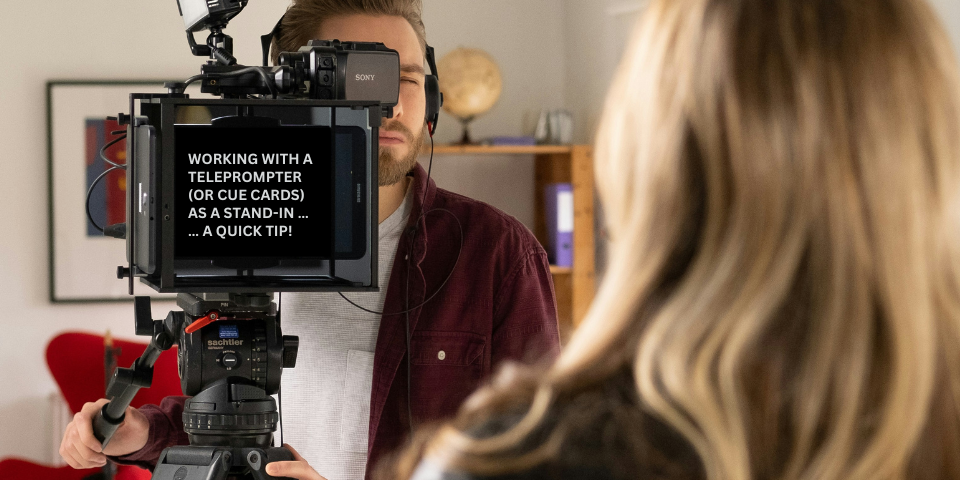The other day, I arrived for background work on a television set. When I got there, the background PA was already making a label for me–I was going to be doing background work and standing in–also known as doing “double-duty.” I did not know this going into the day, so I now had a number of additional responsibilities to attend to in my day.
Standing in when you’re also handling background work can be pretty challenging, as many actors who have been pulled to stand in can attest. Oftentimes, these stand-ins have to rotate out of standing in into immediately doing background in the same scenes they’re working. They may not have a moment to get to the bathroom or grab a bite to eat from craft service. Also, they may be run ragged in managing color cover and their background wardrobe on a day they’re pulled.
Here are some pointers for those times when you’re standing in and doing background, in order to keep your head straight in the madness.
Take Charge of Your Work
When it comes down to it, when you’re standing in, production is going to care that you are on set, ready to work, with the appropriate color cover (and shoes, as needed). Production is not going to care that the wardrobe truck is far away, that holding is far away, or that you’re also doing background work. They will want you when they want you, and they will not want to wait for you when you are needed.
Insofar as this is true, when you arrive to background work and find you are also standing in, it is good policy to take charge of your day as opposed to letting the background PA dictate your day. This is good advice because while the background PA may be the utmost professional, the PA’s head may be swimming with many other logistics of the day for the general background, which may leave the details of your logistics as a day-playing stand-in an afterthought.
Taking charge of your day implies being proactive and assertive in finding out answers to questions you have with respect to fulfilling your responsibilities both as a background actor and as a stand-in. In a given scene, on most sets your responsibilities as a stand-in are greater than your responsibilities as a background actor, but generally you should not presume this. Instead, you should assume that both responsibilities are of equal importance, and you should endeavor to fulfill them all.
Checklist of Needed Information
If you were just standing in, you probably would let the background PA dictate your day when the PA finds it important to share. But if you are also standing in, this “need-to-know basis” approach is probably ineffective for you in fulfilling your job responsibilities.
As soon as you find out you are standing in, see if you can get answers to these important questions with respect to your work. If there is a line of actors checking in, make these queries as quick and direct as possible as not to hold up the check-in line.
- Find out if sides are available to you. Usually they are, and getting them should be primary because your sides can answer a number of your questions, like locations of set and the wardrobe department, the scenes your actor is in, etc.
- Find out the number of your actor for whom you’re standing in. Clarify for yourself the character’s name and the name of the actor playing the character by looking at the callsheet on the front of the sides, but if you can’t figure this out on your own, ask the background PA.
- Find out if you need color cover, and if you do, find out where the wardrobe department is located. Sometimes the wardrobe department is on another floor; sometimes the wardrobe department is in a truck blocks away. Get as specific an address of the department as possible from the background PA.
- Find out how soon you are needed. If you are needed in a scene several hours from now, you can probably relax with respect to getting color cover, reading sides, etc. However, if you are needed in the first scene of the day, you probably need to prioritize your readying yourself to stand in. This probably means making your way to set as soon as possible so that when crew is in, you are on set.
- Find out the location of set! If you’re in a movie studio with multiple stages, make sure you know on what stage (and set) you need to be. If you’re on location, find out the address of the set. If you need to get on a van to go to set, make sure you aren’t out of touch with the background PA as you get color cover, wardrobe approval, etc.
With answers to these questions, you can start to calculate where you need to be and when. If you’re in the first scene, you may need to go straight to the wardrobe department for color cover and then set.
Obviously, showing up early to any set you work on can help temper the madness that might befall you should you learn you’re standing in.
Ben’s Tip!
Wherever you go on set, take with you your voucher and your union card (or ID). These may be necessary in order to get color cover, wardrobe for background work, or props. Leaving them in holding when you head to set may delay your getting to set, but also interfere with your ability to fulfill your background responsibilities.
Taking Care of Background Responsibilities
Although you may be standing in in the first scene of the day and unable to get approved from wardrobe, hair, and makeup, you will still need to get each department’s approval.
Once first team has arrived on set and you’ve been excused as a stand-in, usually the background PA will be on set. Seek out the background PA and explain you still need to get approved from wardrobe, hair, and makeup (or whatever department still hasn’t approved you). Usually this puts the burden on the background PA to take responsibility over your getting approved and directing you on what to do next. This also signals the background PA that you can’t be used as background until you get these approvals.
Should you see a crew member from any of these departments who handles background actors, see if you can get approved then. However, if it’s unclear to this crew member that you are also standing in, make sure you don’t get too involved with their readying you that you delay your arrival back on set when you’re needed to stand in. Manage your time with the departments, still stay close to set, and prioritize your standing in over whatever readying is needed.
Watching for Your Actor’s Blocking Changes When Doing Background
Part of your responsibilities as a stand-in is watching the monitors for changes in your actor’s blocking. When you’re doing background in the same scene in which you’re also standing in, watching monitors is not possible, so you may not be able to note your actor’s blocking changes.
This situation is a regular conflict of interest for the stand-in also doing background. In order to resolve it, I do any number of things.
- In some instances, when my actor has a lot of blocking in the scene, I ask the background PA who wants to use me if I can sit this scene out in order to watch the blocking. When I can watch the blocking, I can be a better stand-in and better assist the crew in later setups.
- In other instances, depending on the feel of the set, I don’t let the conflict of interest bother me and simply keep in mind there is no way for me to know changes in blocking when I’m also doing background work. When I return to standing in and am asked about blocking changes, I simply explain “I was doing background in the scene so I don’t know,” which tends to lead crew to seek answers from an AD.
Some sets tend to avoid the conflict of interest by letting background actors sit out background work from the scenes in which they’re standing in. This policy may be unspoken; it may apply generally but not always; or it may never apply. Always be ready to do background work when you’re also standing in unless you’re told you can relax from background during the scene.
Managing Color Cover and Background Wardrobe
When you’re excused from set after standing in, you may need to remove your color cover in order to wear your background wardrobe. Then, when you’re told to relax from background, you may need to put back on your color cover in order to stand in. If either wardrobe is involved in putting on or taking off, you have yourself an ordeal!
In these cases, you may need to organize your various clothing options in order to quickly change into them. There may be no simple option, so “doing your best” may satisfy production. If getting into color cover is too difficult to do when you’re also doing background, let the background PA or 2nd 2nd AD know, should either want to sit you out from background in that scene.
Remember Your Label!
If you’re wearing a stand-in label (that is, that piece of tape with your name and your character’s name), make sure to take it off when you’re doing background work!
It will help if you affix your label to your color cover so that when you remove your color cover to wear your background wardrobe, you don’t have to worry about it. However, you might not be wearing color cover, in which case your label is on your background wardrobe. You’ll need to devise some method for yourself for remembering to take it off.
If your label is on your background wardrobe, your label may pull at the fabric of your wardrobe or leave a residue when you take it off. Be mindful of where you affix your label so that you don’t damage your background wardrobe, but also make sure to keep it visible for the crew so they know your name.
Keep track of your label, too. If you continually take it off and put it back on, it often will lose its stickiness and may fall off. If you lose yours and it’s important, ask the background PA for another label.
Managing Your Personal Needs
When it comes to taking a quick break to get to the bathroom or to grab a bite to eat, you need to take initiative. If you find yourself trapped in a long cycle of standing in and doing background when you need to get to the bathroom, communicate to the background PA or 2nd 2nd AD that you need to go to the bathroom (“go 10-1”). In most cases, your wish will be granted without objection. Keep in mind, though, you may be needed back on set as soon as possible to do background work, especially if you are matching a previous shot you were in.
Food may be delivered on set by craft services, and you are usually entitled to that food as a member of the crew. These deliveries may stave off the need to visit the craft service table. However, if the food arrives when you are in the middle of standing in, getting food for yourself may be impossible. You might ask an available stand-in to get you some food, or you might be able to get the 2nd 2nd AD or a key PA to help you. If worst comes to worst, treat your hunger or dietary needs like your bathroom needs and take initiative in getting food.
Meals
When you break for a meal, when you’re both a background actor and stand-in, you usually eat when crew eats. This means you are permitted to eat in line ahead of the other background actors. The thinking is that since you’re technically crew when you are a stand-in, you gain this privilege. But this privilege is bolstered by the thinking that you may be needed to stand in immediately after the meal, so you need maximal meal time.
Keep in mind that you may have a shorter meal break than the rest of background (say, a half-hour rather than an hour), especially if you are standing in in the first scene after lunch. Also keep in mind any color cover needs you may have as you come out of your meal break and go back to work.
Ben’s Tip!
Regardless of whether you’re standing in after the meal or not, you are regarded as crew all day, so you are entitled to eat with crew and before the other background actors at all meals during the day. Consider this a perk of standing in!
Checking Out
Remember that when you’re standing in, in most cases you will work at a higher rate. Note on your voucher “Stand In” in the appropriate place. And if you worked as a stand-in in circumstances unlike how you worked background (say that you stood in in smoke or wet conditions), make sure you note those circumstances on your voucher as well.
Conclusion
While not all days when you’re pulled to stand in will be difficult, doing both background and standing in can present unique challenges that a day of simply either doesn’t present. Realize that “stand-in/background actor” is a harder job than just “background actor” or “stand-in,” so stay on top of the responsibilities in order to preserve your own personal sanity as you work on set.
Any other tips for handling background work when you’re also standing in? Have a trick for remember to take off your label when you’re going to do background? If so, post a comment below!






I especially liked that you mentioned the conflict of interest about trying to watch for changes in the actor’s blocking in the scene while still doing background in that scene. It is important to feel out the particular set you are on and just do what you can!